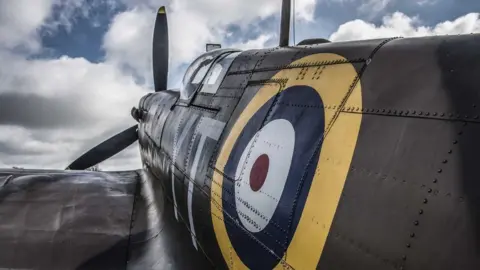Spitfire engine fail due to lack of fuel - report
 Getty Images
Getty ImagesA Spitfire's engine failed because of "fuel starvation", causing a pilot to make an emergency landing, investigators have said.
The aeroplane pitched onto its nose, damaging the propeller and left wing, while landing at Pitsford Airfield, near Sywell, Northamptonshire, at 14:00 BST on 6 May.
An Air Accidents Investigation Branch report found the Spitfire IXT G-LFIX's pilot had transferred fuel supply from the wing tanks to the fuselage train, which led to the engine cutting out.
As a result, the 62-year-old pilot, who had one passenger aboard, had "unknowingly" reduced the fuel level in the wing tank.
'Fuel inlet airlock'
The report into the forced landing found the aircraft was on its third flight of the day and had not been re-fuelled since before the first flight.
The pilot was approaching Sywell from the west when he transferred the fuel supply from the wing tanks to the fuselage tank.
About 30 seconds later, the engine cut out when the aircraft was flying about 2,000ft (610 metres) above ground level.
The report said the pilot realised he did not have sufficient height to make it to Sywell.
He transmitted a mayday call, briefed the passenger to prepare for landing and opted to land at the nearer private grass airstrip at Pitswell Airfield.
Investigators said about "60 imperial gallons [273 litres] of fuel were drained from the wing tanks, however the fuselage tank was found to be empty".
"When the fuel was depleted [from the fuselage tank supplying the engine], the electrical pump continued to pump air, creating an airlock in the fuel inlet," they said.
But when the pilot tried to return the fuel supply from the wing tanks, it was unable to overcome the airlock and the engine could not re-start.
"The loss of engine power was attributed to fuel starvation due to depletion of fuel in the fuselage tank supplying the engine," the report concluded.
The World War Two aeroplane had been converted to a two-seat trainer for the Irish Air Corps after the war.
After retiring from service, restoration work began in 1979.
Since the forced landing, changes have been implemented to the operating procedures to minimise the possibility of a reoccurrence.
Follow Northamptonshire news on BBC Sounds, Facebook, Instagram and X.
